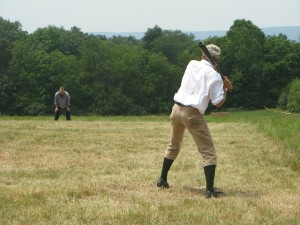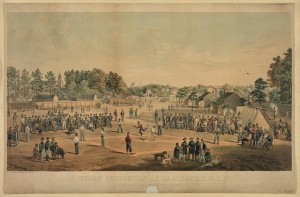Some 30 men who either played or managed major league baseball served in the Civil War. In addition, three of the first five National League presidents wore the Union blue in the “War Between the States.”
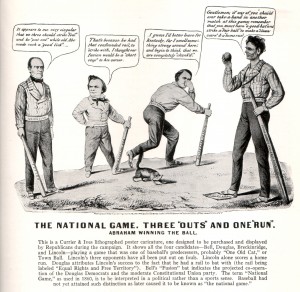 Baseball existed before the Civil War, but the conflict that profoundly changed America did the same for the game that would become the national pastime.
Baseball existed before the Civil War, but the conflict that profoundly changed America did the same for the game that would become the national pastime.
“The Civil War years proved crucial in securing the game’s place in the American heart,” according to the Princeton University Press, which published Baseball in Blue and Gray: The National Pastime in the Civil War by George B. Kirsch. “Soldiers with bats in their rucksacks spread baseball to training camps, war prisons and even front lines.”
“But tracking down and verifying all the athletes who both served in the Civil War and played major league baseball some 150 years after the war ended is a frustrating process. In fact, even the nation’s most esteemed group of baseball researchers says producing a definitive list simply can’t be done.
“Proving that a particular player was a Civil War veteran is often very difficult,” according to the Society for American Baseball Research (SABR). “Proving that someone was not a veteran is impossible unless they were too young to have served.”
Nonetheless, SABR says there is “persuasive” evidence that 30 major league players and managers were Civil War veterans. Most had brief military and equally undistinguished playing careers. Of those on SABR’s list, only seven saw combat and only one is confirmed to have been wounded. None are in baseball’s Hall of Fame.
In fact, only one member of the Hall of Fame is a Civil War veteran, and he was inducted as a non-playing executive.
First ‘Major League’ Game
Dennis Coughlin might be baseball’s most grizzled Civil War vet, fighting in three famous battles: Gettysburg The Wilderness and Petersburg. While serving as a corporal with company E, New York 140th Infantry Regiment on June 26, 1864, he was wounded at Petersburg. He earned a promotion to sergeant on March 1, 1865 and was mustered out of service three months later on June 3.
Coughlin went on to play eight games in the 1872 season for the Washington Nationals. the team actually recruited Coughlin, enticing him with a clerical job at the U.S. Treasury in the days before baseball was openly professional
About a year after Coughlin enlisted Tom Carey of Brooklyn joined Company C, 17th New York Infantry on Sept. 17, 1863 and was discharged in July 1865. During his service, the 17th fought in battles at Atlanta; Jonesboro, Ga.; and Bentonville, N.C.
Carey was a star infielder for the Baltimore Marylands before defecting to the Fort Wayne Kekiongas late in the 1870 season. As the second baseman for Fort Wayne, he played in the first “all-professional” major league game May 4, 1871, against the Cleveland Forest Citys. In all, Carey played nine seasons of major league baseball, five in the National Association (1871-75) and four in the National League (1876-79).
Playing for Cleveland in that May 4, 1871, game was another combat vet of the Civil War. Albert G. Pratt was a 100-day enlistee with Company G, 193rd Pennsylvania Infantry from July-November 1864. He re-enlisted with Company I, 61st Pennsylvania Infantry in February 1865 and fought in the final assault on Petersburg on April 2, 1865, and at the Battle of Sayler’s Creek four days later.
As a pitcher, Pratt “delivered the ball with remarkable speed despite his slight (5’7″, 140 lbs.) build and laborious motion,” according to William Ryczek in When Johnny Came Sliding Home: The Civil War Baseball Boom (1865-70). As an executive, Pratt assisted in formation of the American Association in 1882 and the Union Association in 1884 In the 1890s he was active in the management of Pittsburgh’s National League team.
Forerunner of the World Series
Another New Yorker, Henry C. Austin fought as a member of Company I, 38th New York Infantry at the first Battle of Bull Run on July 21, 1861. He claimed, on an 1890 veterans census, that he served until 1865.
In 1873, Austin played one season for the Elizabeth (N.J.) Resolutes of the National Association, tying for the team lead in runs batted in with 11.
Frank Erwin “Ham” Allen also saw combat before turning to baseball. He served with Company F, 36th Massachusetts Infantry. That regiment fought at Jackson, Miss., on May 14, 1863, and at Blue Springs, Tenn., on Oct. 10, 1863. Allen served from Aug. 18, 1862-Oct. 21, 1863.
The 5-foot-4 inch soldier would go on to play 17 games as an infielder and outfielder for the Middletown (Conn.) Mansfields in 1872.
Unlike Allen, Frank Bancroft would make his name in baseball as a manager. Before that, though, he enlisted as a musician in Company A, 8th New Hampshire Infantry on Sept. 26, 1861. SABR notes that Bancroft was “wounded in the line of duty,” but doesn’t specify when or where. Bancroft completed his enlistment by serving “in the Invalid Corps and the Veteran Reserve Corps until the end of the war.”
In the major leagues, Bancroft managed (but never played for) seven teams over nine seasons. His most successful year was 1884 when he piloted the Providence Grays of the National League to baseball’s first post-season clash of league champions.
Bancroft’s Grays defeated the New York Metropolitans of the American Association in the best-of-three series earning the title “world champions” from the newspaper, The Sporting Life. the competition was the forerunner to the modern World Series, first played in 1903.
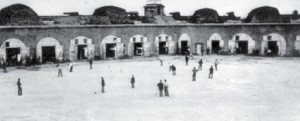
The only known photograph of baseball being played during the Civil War. This is believed to have been taken at Fort Pulaski.
Though not wounded, midwesterner Alfred L. Barker also saw combat in the war. The Rockford, Ill.-native enlisted in Company D, 11th Illinois Infantry in April 1861 and mustered out three months later. He re-enlisted as a second lieutenant with Company A, 74th Illinois Infantry in September 1862 and fought at the Battle of Stones River in Murfreesboro, Tenn., where 3,024 Union and Confederate troops were killed. Barker’s brother, Henry, was killed June 27, 1864, at the Battle of Kennesaw Mountain in Georgia.
A founding member and lifelong supporter of the Rockford Forest Citys, Barker actually played only one official major league game after his team joined the National Association in 1871. As the starting left fielder on June 1 that year, he went one-for-four with two RBIs in a 7-3 road loss to the New York Mutuals.
Threat Forces 100-Days Enlistments
Of those who served in the war, John Dickson “Dick” McBride was the most accomplished ball player, logging a 15-year career. And like several other players from Pennsylvania, he served a 100-day enlistment in 1864 when Confederate Gen. Jubal Early launched assaults in the Shenandoah Valley that threatened Washington, D.C.; Baltimore and southern Pennsylvania.
McBride enlisted as a private with Company A at Pennsylvania’s 196th Infantry Regiment on July 15 and was mustered out on Nov. 17, 1864. A “notorious umpire baiter,” the hard-throwing pitcher played for the Philadelphia Athletics from 1861-76.
Another Pennsylvanian who served a 100-day enlistment in 1864 was Douglas Allison. He joined Company L of Pennsylvania’s 192nd Infantry on July 12 and mustered out Nov. 11. Allison later played for baseball’s first all-professional team, the Cincinnati Red Stockings, in 1869 as “one of the finest catchers in the country,” according to The (New York) Clipper.
During Allison’s 12-year baseball career, he was the first recorded player to use protective gear for his hands when he “donned a light pair of buckskin gloves” on June 29, 1870.
Besides Pratt, McBride and Allison, four other ballplayers (Thomas Haney Berry, Winfield Scott Hastings, Fergus G. Malone and William Parks) served 100-day enlistments during the Civil War. All but Hastings, who hailed from Illinois, were from Pennsylvania.
There could be more Civil War vets who played major league baseball, but verifying evidence - such as pension applications filed by the vets widows or, less compelling, statements made by the veterans themselves - will be more difficult as time goes on.
So far, less than three dozen have been verified. It is an elite group: men who both served the nation in uniform during wartime and as pioneering professionals in the most American of games.
Still, they left a lasting legacy.
“The ties between baseball and the American nation first forged in the Civil War continue into the 21st century,” George Kirsch wrote.
E-Mail [email protected]
We Need Your Help
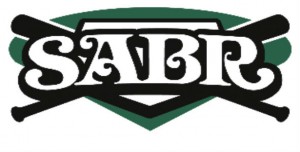 SABR says its research into the subject “remains a work in progress” and would be interested in hearing from anyone who might have information on players overlooked.
SABR says its research into the subject “remains a work in progress” and would be interested in hearing from anyone who might have information on players overlooked.
VFW magazine is also interested in comments from readers about Civil War veterans - as well as those serving in subsequent conflicts - who played major league baseball and other professional sports. E-Mail [email protected]
SIDEBAR: First National League President was a Civil War Veteran
Three Civil War veterans served as National League presidents.
Morgan Bulkeley was the league’s first president in 1876 and is enshrined as such in Cooperstown, the National Baseball Hall of Fame in New York. Bulkeley served with Company G, 13th New York Infantry.
Abraham G. Mills was the league’s fourth president from 1883-84. He joined the 5th New York Volunteers in 1862 and was discharged in 1865 as a second lieutenant. In 1907, he headed the Mills Commission which concluded, based on rather flimsy evidence, the Union Civil War Gen. Abner Doubleday invented baseball in 1839 in Cooperstown.
In fact, baseball’s Hall of Fame recognizes Alexander Cartwright as the true father of baseball. Cooperstown says Cartwright organized the first baseball club - the New York Knickerbockers - in 1845 and formed the fundamenal rules of the game.
Nicholas Ephraim Young - in addition to a three-year managing career - served as secretary of the National Association in 1871. He succeeded Mills as National League boss from 1885-1902. Young enlisted with Company D, 32nd New York Infantry in 1862 and transferred to the 121st New York Inf., in 1863.
LIST OF PLAYERS, MANAGERS
IN ADDITION to those profiled in this article, here is SABR’s list of major league players and managers who served in the Civil War. SABR cautions, however, that not all have been “positively established” as war vets and others “may emerge” as more information becomes available.
Nathan Berkenstock
Henry Washburn Berthrong
Oscar Bielaski
David Birdsall
Louis A. Carl
William H. Craver
Washington Fayette Fulmer
James H. Gifford
John A. Greenig
Nathan W. Jewett
Caleb Clark Johnson
Alphonse C. Martin
Edwin B. Pinkham
Seymour Studley
William Warren White
Click here for this interesting story of baseball in the Washington, D.C. area during the Civil War.

